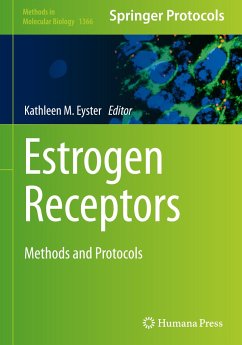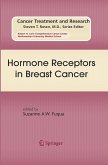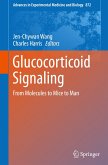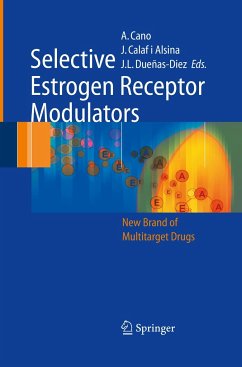Estrogen Receptors
Methods and Protocols
Herausgegeben:Eyster, Kathleen M.
Estrogen Receptors
Methods and Protocols
Herausgegeben:Eyster, Kathleen M.
- Gebundenes Buch
- Merkliste
- Auf die Merkliste
- Bewerten Bewerten
- Teilen
- Produkt teilen
- Produkterinnerung
- Produkterinnerung
This volume examines a wide array of vital technologies for advancing our understanding of the receptor-mediated actions of estrogen. The protocols in this book range from standard methods and vital laboratory workhorses, such as receptor binding assays and western blot, to newer technologies such as RNAseq and proximity ligation assay. Chapters also discuss protocols from a broad range of tissue types to demonstrate the variety of estrogen receptor effects. Written in the highly successful Methods in Molecular Biology series format, chapters include introductions to their respective topics,…mehr
Andere Kunden interessierten sich auch für
![Hormone Receptors in Breast Cancer Hormone Receptors in Breast Cancer]() Hormone Receptors in Breast Cancer82,99 €
Hormone Receptors in Breast Cancer82,99 €![Biological Reactive Intermediates III Biological Reactive Intermediates III]() Biological Reactive Intermediates III82,99 €
Biological Reactive Intermediates III82,99 €![Glucocorticoid Signaling Glucocorticoid Signaling]() Glucocorticoid Signaling112,99 €
Glucocorticoid Signaling112,99 €![Tissue-Specific Estrogen Action Tissue-Specific Estrogen Action]() Tissue-Specific Estrogen Action112,99 €
Tissue-Specific Estrogen Action112,99 €![Selective Estrogen Receptor Modulators Selective Estrogen Receptor Modulators]() Selective Estrogen Receptor Modulators75,99 €
Selective Estrogen Receptor Modulators75,99 €![Immunology of Endometriosis Immunology of Endometriosis]() Immunology of Endometriosis157,99 €
Immunology of Endometriosis157,99 €![Metabolism of Human Diseases Metabolism of Human Diseases]() Metabolism of Human Diseases67,99 €
Metabolism of Human Diseases67,99 €-
-
-
This volume examines a wide array of vital technologies for advancing our understanding of the receptor-mediated actions of estrogen. The protocols in this book range from standard methods and vital laboratory workhorses, such as receptor binding assays and western blot, to newer technologies such as RNAseq and proximity ligation assay. Chapters also discuss protocols from a broad range of tissue types to demonstrate the variety of estrogen receptor effects. Written in the highly successful Methods in Molecular Biology series format, chapters include introductions to their respective topics, lists of the necessary materials and reagents, step-by-step, readily reproducible laboratory protocols, and tips on troubleshooting and avoiding known pitfalls.
Cutting-edge and thorough, Estrogen Receptors: Methods and Protocols is a detailed and helpful resource for scientists who are intrigued by the many facets of estrogen.
The chapter 'Bioinformatics Analysisof Estrogen-Responsive Genes' is open access under a CC BY 4.0 license.
Cutting-edge and thorough, Estrogen Receptors: Methods and Protocols is a detailed and helpful resource for scientists who are intrigued by the many facets of estrogen.
The chapter 'Bioinformatics Analysisof Estrogen-Responsive Genes' is open access under a CC BY 4.0 license.
Produktdetails
- Produktdetails
- Methods in Molecular Biology 1366
- Verlag: Humana / Springer New York / Springer, Berlin / Wellcome Trust
- Artikelnr. des Verlages: 978-1-4939-3126-2
- 1st ed. 2016
- Seitenzahl: 600
- Erscheinungstermin: 20. November 2015
- Englisch
- Abmessung: 260mm x 183mm x 36mm
- Gewicht: 1366g
- ISBN-13: 9781493931262
- ISBN-10: 1493931261
- Artikelnr.: 43044862
- Herstellerkennzeichnung Die Herstellerinformationen sind derzeit nicht verfügbar.
- Methods in Molecular Biology 1366
- Verlag: Humana / Springer New York / Springer, Berlin / Wellcome Trust
- Artikelnr. des Verlages: 978-1-4939-3126-2
- 1st ed. 2016
- Seitenzahl: 600
- Erscheinungstermin: 20. November 2015
- Englisch
- Abmessung: 260mm x 183mm x 36mm
- Gewicht: 1366g
- ISBN-13: 9781493931262
- ISBN-10: 1493931261
- Artikelnr.: 43044862
- Herstellerkennzeichnung Die Herstellerinformationen sind derzeit nicht verfügbar.
Kathleen (Kathy) Eyster Professor of Physiology and Pharmacology Sanford School of Medicine of the University of South Dakota 605-677-5159
The Estrogen Receptors: An Overview from Different Perspectives.- Competitive Binding Assay for the G-Protein Coupled Receptor 30 (GPR30) or G-Protein Coupled Estrogen Receptor (GPER).- The Use of Real Time Reverse Transcription-PCR for Assessing Estrogen Receptor and Estrogen-Responsive Gene Expression.- Bioinformatics Analysis of Estrogen-Responsive Genes.- Electrophoretic Mobility Shift Assay (EMSA) and Supershift Assay of Cytochrome P450 2B6 in Response to Estrogen.- Chromatin Immunoprecipitation Assay to Identify Genomic Binding Sites of Regulatory Factors.- Chromatin Immunoprecipitation with Estrogen Receptor 1 and the Promoter of Greb1 in TM4 Sertoli Cells.- Chromatin Immunoprecipitation-Sequencing (ChIP-seq) for Mapping of Estrogen Receptor-Chromatin Interactions in Breast Cancer.- RNA-Seq Experiment and Data Analysis.- DNA Microarray Analysis of Estrogen-Responsive Genes.- Shotgun Proteomics Analysis of Estrogen Effects in the Uterus Using Two Dimensional Liquid Chromatography and Tandem Mass Spectrometry.- Assessment of Protein Expression by Proximity Ligation Assay in the Nonhuman Primate Endometrium, Placenta, and Fetal Adrenal in Response to Estrogen.- Co-Localization of Estrogen Receptors with the Fluorescent Tamoxifen Derivative, FLTX1, Analyzed by Confocal Microscopy.- Live Cell Imaging of the Estrogen Receptor by Total Internal Reflection Fluorescence Microscopy.- In Situ Hybridization of Estrogen Receptors and beta and GPER in the Human Testis.- Purification of Histone Lysine Methyltransferase SMYD2 and Co-Crystallization with a Target Peptide from Estrogen Receptor a.- Gold Nanoparticle-Based Förster Resonance Energy Transfer (FRET) Analysis of Estrogen Receptor: DNA Interaction.- Analysis of Interaction of Estradiol with Estrogen Receptor by NMR Spectroscopy.- Application of Circular Dichroism Spectroscopy to the Analysis of the Interaction between the Estrogen Receptor Alpha and Co-Activators: The Case of Calmodulin.- Surface Plasmon Resonance Study of Cooperative Interactions of Estrogen Receptor and Specificity Protein 1 with Composite DNA Elements.- Tips and Tricks for Successful Application of Statistical Methods to Biological Data.- The Synonymous Ala87 Mutation of Estrogen Receptor Alpha Modifies Transcriptional Activation through Both ERE and AP1 Sites.- Selective Estrogen Receptor Modulators and the Tissue-Selective Estrogen Complex: Analysis of Cell Type-Specific Effects using In Vivo Imaging of a Reporter Mouse Model.- Use of Reporter Genes to Analyze Estrogen Response: The Transgenic Zebrafish Model.- Comparison of the Effects of the Selective Estrogen Receptor Modulators Ospemifene, Raloxifene, and Tamoxifen on Breast Tissue in Ex Vivo Culture.- Estrogen Receptor Agonists and Antagonists in the Yeast Estrogen Bioassay.- Silencing Estrogen Receptor- with siRNA inthe Intact Rodent Brain.- Silencing Estrogen Receptor-beta with siRNA in Cultured Cells.- Experimental Procedures for Demonstration of MicroRNA Mediated Enhancement of Functional Neuroprotective Effects of Estrogen Receptor Agonists.- Expression Profiles of Estrogen-Regulated MicroRNAs in Breast Cancer Cells.- Estradiol-Induced Transcriptional Regulation of Long Non-Coding RNA, HOTAIR.-Detection and Functional Analysis of Estrogen Receptor Phosphorylated at Serine 216 in Mouse Neutrophils.- Estrogen Receptor- Knockout Mice.- Detection of Endogenous Selective Estrogen Receptor Modulators such as 27-Hydroxycholesterol.- Phytoestrogens Activate the Estrogen Receptor in HepG2 Cells.- Detection of the Phosphorylation of the Estrogen Receptor a as an Outcome of GPR30 Activation.- GPER Mediates Non-Genomic Effects of Estrogen.- GPER/GPR30 Knockout Mice: Effects of GPER on Metabolism.- Analysis of G-Protein Coupled Receptor 30 (GPR30) on Endothelial Inflammation.- Atherosclerosis and Vascular Biologic Responses to Estrogens: Histologic, Immunohistochemical, Biochemical, and Molecular Methods.- Assessing Direct Vascular Actions of Estrogens.- Molecular Design, Synthesis, and Evaluation of SNIPER(ER) that Induces Proteasomal Degradation of ER .- Regulation of Activation Induced Deaminase (AID) by Estrogen.
The Estrogen Receptors: An Overview from Different Perspectives.- Competitive Binding Assay for the G-Protein Coupled Receptor 30 (GPR30) or G-Protein Coupled Estrogen Receptor (GPER).- The Use of Real Time Reverse Transcription-PCR for Assessing Estrogen Receptor and Estrogen-Responsive Gene Expression.- Bioinformatics Analysis of Estrogen-Responsive Genes.- Electrophoretic Mobility Shift Assay (EMSA) and Supershift Assay of Cytochrome P450 2B6 in Response to Estrogen.- Chromatin Immunoprecipitation Assay to Identify Genomic Binding Sites of Regulatory Factors.- Chromatin Immunoprecipitation with Estrogen Receptor 1 and the Promoter of Greb1 in TM4 Sertoli Cells.- Chromatin Immunoprecipitation-Sequencing (ChIP-seq) for Mapping of Estrogen Receptor-Chromatin Interactions in Breast Cancer.- RNA-Seq Experiment and Data Analysis.- DNA Microarray Analysis of Estrogen-Responsive Genes.- Shotgun Proteomics Analysis of Estrogen Effects in the Uterus Using Two Dimensional Liquid Chromatography and Tandem Mass Spectrometry.- Assessment of Protein Expression by Proximity Ligation Assay in the Nonhuman Primate Endometrium, Placenta, and Fetal Adrenal in Response to Estrogen.- Co-Localization of Estrogen Receptors with the Fluorescent Tamoxifen Derivative, FLTX1, Analyzed by Confocal Microscopy.- Live Cell Imaging of the Estrogen Receptor by Total Internal Reflection Fluorescence Microscopy.- In Situ Hybridization of Estrogen Receptors and beta and GPER in the Human Testis.- Purification of Histone Lysine Methyltransferase SMYD2 and Co-Crystallization with a Target Peptide from Estrogen Receptor a.- Gold Nanoparticle-Based Förster Resonance Energy Transfer (FRET) Analysis of Estrogen Receptor: DNA Interaction.- Analysis of Interaction of Estradiol with Estrogen Receptor by NMR Spectroscopy.- Application of Circular Dichroism Spectroscopy to the Analysis of the Interaction between the Estrogen Receptor Alpha and Co-Activators: The Case of Calmodulin.- Surface Plasmon Resonance Study of Cooperative Interactions of Estrogen Receptor and Specificity Protein 1 with Composite DNA Elements.- Tips and Tricks for Successful Application of Statistical Methods to Biological Data.- The Synonymous Ala87 Mutation of Estrogen Receptor Alpha Modifies Transcriptional Activation through Both ERE and AP1 Sites.- Selective Estrogen Receptor Modulators and the Tissue-Selective Estrogen Complex: Analysis of Cell Type-Specific Effects using In Vivo Imaging of a Reporter Mouse Model.- Use of Reporter Genes to Analyze Estrogen Response: The Transgenic Zebrafish Model.- Comparison of the Effects of the Selective Estrogen Receptor Modulators Ospemifene, Raloxifene, and Tamoxifen on Breast Tissue in Ex Vivo Culture.- Estrogen Receptor Agonists and Antagonists in the Yeast Estrogen Bioassay.- Silencing Estrogen Receptor- with siRNA inthe Intact Rodent Brain.- Silencing Estrogen Receptor-beta with siRNA in Cultured Cells.- Experimental Procedures for Demonstration of MicroRNA Mediated Enhancement of Functional Neuroprotective Effects of Estrogen Receptor Agonists.- Expression Profiles of Estrogen-Regulated MicroRNAs in Breast Cancer Cells.- Estradiol-Induced Transcriptional Regulation of Long Non-Coding RNA, HOTAIR.-Detection and Functional Analysis of Estrogen Receptor Phosphorylated at Serine 216 in Mouse Neutrophils.- Estrogen Receptor- Knockout Mice.- Detection of Endogenous Selective Estrogen Receptor Modulators such as 27-Hydroxycholesterol.- Phytoestrogens Activate the Estrogen Receptor in HepG2 Cells.- Detection of the Phosphorylation of the Estrogen Receptor a as an Outcome of GPR30 Activation.- GPER Mediates Non-Genomic Effects of Estrogen.- GPER/GPR30 Knockout Mice: Effects of GPER on Metabolism.- Analysis of G-Protein Coupled Receptor 30 (GPR30) on Endothelial Inflammation.- Atherosclerosis and Vascular Biologic Responses to Estrogens: Histologic, Immunohistochemical, Biochemical, and Molecular Methods.- Assessing Direct Vascular Actions of Estrogens.- Molecular Design, Synthesis, and Evaluation of SNIPER(ER) that Induces Proteasomal Degradation of ER .- Regulation of Activation Induced Deaminase (AID) by Estrogen.








